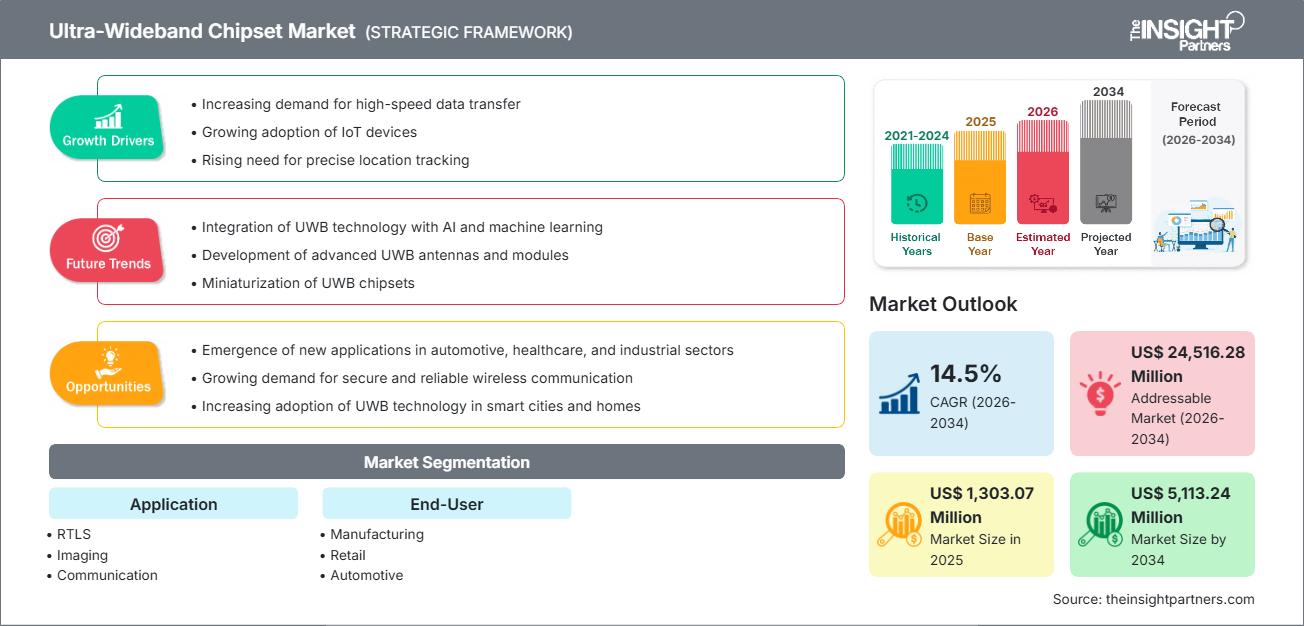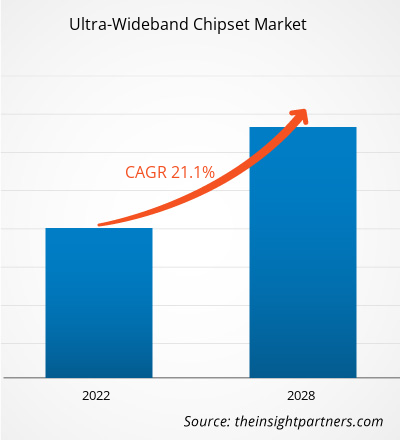超広帯域チップセット市場規模は2025年に13億307万米ドルと評価され、2026年から2034年にかけて14.5%のCAGRで成長し、2034年には51億1,324万米ドルに達すると予想されています。
超広帯域チップセット市場分析
超広帯域(UWB)チップセット市場は、リアルタイム位置情報システム(RTLS)におけるUWB技術の採用増加、高精度の資産追跡の需要、民生用および産業用デバイスへのUWBの統合により、堅調に成長すると予測されています。
UWB テクノロジーは、従来の RTLS アプローチ (RFID、Wi-Fi ベースの測位など) と比較して、より高い精度、より広い帯域幅、より低い消費電力、およびより優れた干渉耐性を備えているため、正確な屋内/屋外の測位と安全な通信を必要とするアプリケーションにとって魅力的です。
さらに、IoT、スマートデバイス、ウェアラブルエレクトロニクス、自動車用アプリケーション(セキュアアクセス、車両の位置特定など)、産業オートメーションなど、UWBチップセットの恩恵を受ける分野の成長も、需要を押し上げています。
超広帯域チップセット市場の概要
超広帯域チップセットは、UWB通信を可能にする集積回路です。UWBは、広帯域周波数スペクトルを用いて短距離、高精度、低消費電力のデータ伝送と測距を行う無線技術です。これらのチップセットは、高精度リアルタイム位置情報システム(RTLS)、安全なアクセス制御、デバイス間通信など、民生用電子機器、自動車、産業、ヘルスケア、小売業などにおける様々なユースケースの実現に不可欠です。
UWB チップセットは、センチメートルレベルの位置情報の精度、低遅延、干渉耐性、エネルギー効率の高い通信を可能にすることで、倉庫内の資産の追跡、スマートフォンの空間認識の有効化、自動車の安全なキーレス エントリの提供など、デバイス メーカーやシステム インテグレーターが堅牢なパフォーマンスを実現できるよう支援します。
正確な測位、リアルタイムの追跡、安全な通信の需要が高まり続ける中、UWB チップセットは複数の業界にわたる重要なインフラストラクチャ コンポーネントとして浮上しています。
要件に合わせてレポートをカスタマイズ
このレポートの一部、国レベルの分析、Excelデータパックなど、あらゆるレポートを無料でカスタマイズできます。また、スタートアップや大学向けのお得なオファーや割引もご利用いただけます。
超広帯域チップセット市場:戦略的洞察

-
このレポートの主要な市場動向を入手してください。この無料サンプルには、市場動向から見積もりや予測に至るまでのデータ分析が含まれます。
超広帯域チップセット市場の推進要因と機会
市場の推進要因:
- 高精度の位置情報と追跡のニーズ: 製造、物流、小売、医療、スマート インフラストラクチャにおける正確なリアルタイム位置情報システム (RTLS) の需要が高まっており、精度の低い代替システムよりも UWB の採用が進んでいます。
- 民生用電子機器とスマート デバイスへの統合の拡大: スマートフォン、ウェアラブル デバイス、スマート ホーム デバイス、IoT ガジェットが普及するにつれて、空間認識、安全な通信、近接ベースの機能を実現するため、UWB チップセットが組み込まれるケースが増えています。
- 自動車アプリケーションの増加: UWB は、安全な自動車への進入、位置特定、通信機能に活用されており、自動車メーカーからのチップセット需要の増加に貢献しています。
- 低電力、干渉耐性の通信の需要: UWB の固有の利点である低遅延、マルチパス/干渉に対する堅牢性、エネルギー効率により、信頼性と精度が求められる現代のワイヤレス システムに適しています。
市場機会:
- 業界全体および新興テクノロジーの使用事例の拡大: 物流、スマート製造、医療資産追跡、小売在庫管理、スマートホーム/オフィス自動化の需要の増加に伴い、UWB チップセットの採用が拡大すると予想されます。
- IoT とスマート デバイスの普及: IoT エコシステムが世界的に拡大するにつれ、ウェアラブル、スマート タグ、デバイス間通信など、より多くのデバイスに UWB チップセットを組み込むことで、大きな成長の可能性が生まれます。
- 自動車とモビリティのイノベーション: 車両アクセス、安全な通信、位置特定における UWB の使用は、自動車 OEM と提携するチップセット ベンダーにとって大きなチャンスを示唆しています。
- 従来の追跡/通信技術からの移行: 企業や消費者がより高い精度とセキュリティを要求するにつれて、UWB は古いシステム (RFID、基本的な Bluetooth など) の代替として登場し、チップセットの普及を促進します。
超広帯域チップセット市場のセグメンテーション分析
用途別:
- リアルタイム位置情報システム(RTLS)
- イメージング
- コミュニケーション
エンドユーザー/業界別:
- 製造業
- 小売り
- 自動車
- 健康管理
- 家電
地理別:
- 北米
- ヨーロッパ
- アジア太平洋
- 南米と中央アメリカ
- 中東・アフリカ
超広帯域チップセット市場の地域別分析
予測期間全体を通して超広帯域チップセット市場に影響を与える地域的なトレンドと要因は、The Insight Partnersのアナリストによって徹底的に解説されています。このセクションでは、北米、ヨーロッパ、アジア太平洋、中東・アフリカ、中南米における超広帯域チップセット市場のセグメントと地域についても解説します。
超広帯域チップセット市場レポートの範囲
| レポート属性 | 詳細 |
|---|---|
| 2025年の市場規模 | 13億307万米ドル |
| 2034年までの市場規模 | 51億1,324万米ドル |
| 世界のCAGR(2026年~2034年) | 14.5% |
| 履歴データ | 2021-2024 |
| 予測期間 | 2026~2034年 |
| 対象セグメント |
アプリケーション別
|
| 対象地域と国 |
北米
|
| 市場リーダーと主要企業の概要 |
|
超広帯域チップセット市場のプレーヤー密度:ビジネスダイナミクスへの影響を理解する
超広帯域チップセット市場は、消費者の嗜好の変化、技術の進歩、製品メリットへの認知度の高まりといった要因によるエンドユーザー需要の増加に牽引され、急速に成長しています。需要の増加に伴い、企業は製品ラインナップの拡充、消費者ニーズへの対応のためのイノベーション、そして新たなトレンドの活用を進めており、これが市場の成長をさらに加速させています。

- 超広帯域チップセット市場のトップキープレーヤーの概要を入手
超広帯域チップセット市場シェアの地域別分析
The Insight Partnersのレポートによると、2021年の市場の地域的展開は、北米、ヨーロッパ、アジア太平洋、ラテンアメリカ、中東、アフリカに及んだ。
歴史的に、アジア太平洋地域は(地域の中でトップの)大きな収益シェアを占めており、北米とヨーロッパがそれに続いています。
地域間の成長は、テクノロジーの採用率、工業化、消費者向け電子機器の普及、自動車の統合、IoT インフラストラクチャの開発に応じて異なると予想され、アジア太平洋地域と新興経済国で特に大きな可能性があります。
競争環境とプレイヤー密度
複数のグローバル企業とニッチなチップセット開発会社の存在が、超広帯域チップセット市場の特徴です。これらのベンダーは、以下の方法で差別化を図っています。
- UWB チップセットを民生用デバイスおよび IoT 向けの多用途 IC に統合します。
- 電力、帯域幅、干渉耐性を最適化する高度なチップセット設計。
- 次世代製品に UWB を組み込むために、デバイス メーカー (スマートフォン、自動車 OEM、産業機器メーカー) と戦略的に連携します。
- さまざまな業種にわたる RTLS、通信、およびイメージング アプリケーション向けに UWB をカスタマイズすることを目的としたイノベーション。
超広帯域チップセット市場で事業を展開する主要企業
- アレレオン株式会社
- アップル社
- ベスプーンSAS
- デカウェーブ・リミテッド
- 太陽誘電株式会社
- ヨハンソンテクノロジー株式会社
- ノベルダAS
- NXPセミコンダクターズNV
- パルスリンク株式会社
調査の過程で分析された他のプレーヤーは次のとおりです。
- テキサス・インスツルメンツ社
- STマイクロエレクトロニクスNV
- サムスン電子株式会社
- ゼブラテクノロジーズ株式会社
- ソニー株式会社
- インフィニオンテクノロジーズAG
- 株式会社村田製作所
- ライトポイントコーポレーション
- セウィオネットワークス株式会社
- ナノトロンテクノロジーズGmbH
超広帯域チップセット市場のニュースと最近の動向
- The Insight Partners による世界レポートでは、UWB チップセット市場が 2028 年までに 19 億 646 万ドルに達すると予測されており、力強い成長が再確認されています。
- UWB は精度が高く、従来の追跡/通信システムを置き換えることができるため、RTLS、民生用デバイス、自動車分野での UWB の導入が拡大しており、これが主要な成長原動力として認識されています。
超広帯域チップセット市場レポートの対象範囲と成果物
The Insight Partnersのレポート「超広帯域チップセット市場の規模と予測(2021~2034年)」では、以下のことが示されています。
- 主要セグメントの世界、地域、国レベルでの詳細な市場規模と予測。
- 市場動向、成長要因、機会、および根本的な市場動向の分析。
- アプリケーション、エンドユーザー、地域によるセグメンテーション。
- 主要なチップセットベンダーの競争環境と企業プロファイリング。
- 過去2年間の分析、基準年、CAGRによる予測(7年間)
- PEST分析とSWOT分析
- 市場規模価値/数量 - 世界、地域、国
- 業界と競争環境
- Excel データセット
最新レポート
お客様の声
購入理由
- 情報に基づいた意思決定
- 市場動向の理解
- 競合分析
- 顧客インサイト
- 市場予測
- リスク軽減
- 戦略計画
- 投資の正当性
- 新興市場の特定
- マーケティング戦略の強化
- 業務効率の向上
- 規制動向への対応






















 無料サンプルを入手 - 超広帯域チップセット市場
無料サンプルを入手 - 超広帯域チップセット市場